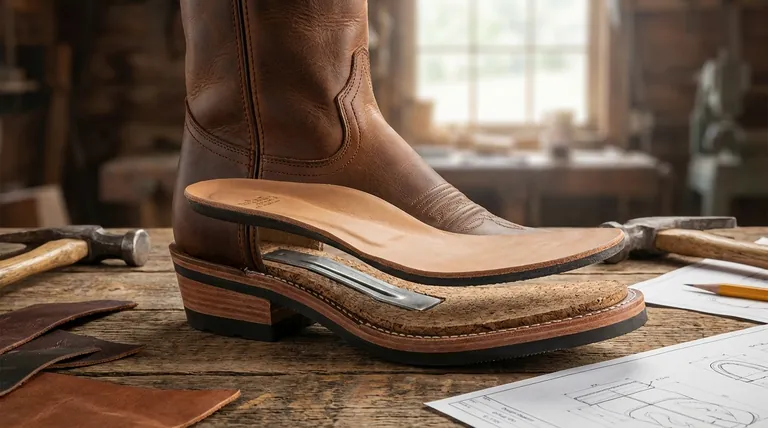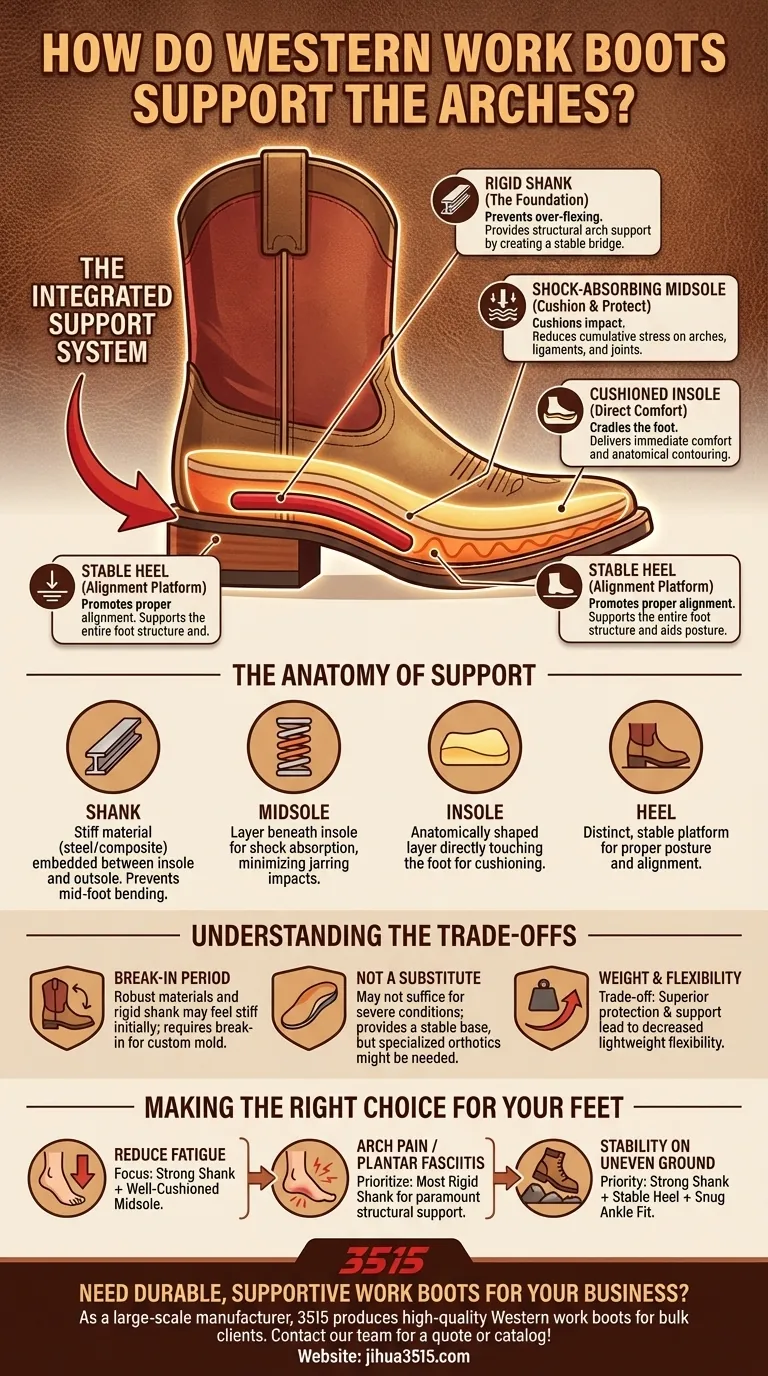At its core, a Western work boot supports the arch primarily through a rigid internal component called a shank. This structural piece runs through the midsole of the boot, providing a stable foundation that prevents the foot from over-flexing and helps maintain its natural alignment, significantly reducing strain during long hours of wear.
The key to understanding Western work boot support is realizing it’s not just one feature, but an integrated system. The rigid shank provides the structural integrity, while the midsole and insole provide the necessary cushioning and shock absorption to protect the foot from impact.

The Anatomy of Support in a Western Work Boot
A well-designed boot functions as a complete system to reduce fatigue and provide stability. The arch support is the centerpiece, but it relies on several other components working in concert.
The Rigid Shank: The Foundation of Arch Support
The shank is the most critical element for true arch support. It is a stiff piece of material, often steel or a strong composite, embedded between the insole and the outsole.
Its primary job is to prevent the boot from bending excessively in the middle of your foot. This rigidity creates a stable bridge that supports your arch, distributing pressure evenly and preventing the strain that leads to conditions like plantar fasciitis.
The Shock-Absorbing Midsole
Beneath the insole lies the midsole, which is designed specifically for shock absorption. This layer cushions your foot with every step, minimizing the jarring impact from walking on hard surfaces.
By reducing overall impact, the midsole lessens the cumulative stress on your arches, ligaments, and joints, which is crucial for preventing fatigue over a long workday.
Cushioned Insoles for Direct Comfort
The insole is the part your foot directly touches. In quality Western work boots, these are more than just a thin layer of foam.
They are anatomically shaped to cradle the foot, providing an initial layer of cushioning and support. While the shank provides the structure, the insole delivers immediate comfort and helps fill the contours of your foot.
The Stable Heel and Ergonomic Design
The distinct heel of a Western boot isn't just for style; it provides a stable platform that helps with proper posture and alignment.
This ergonomic design, combined with the boot's overall anatomical shape, supports the entire structure of your foot, ensuring the arch is positioned correctly and not bearing an undue load.
Understanding the Trade-offs
The features that make Western work boots so supportive also introduce certain considerations. Understanding these trade-offs is key to making an informed decision.
The Break-In Period
The same robust materials and rigid shank that provide excellent support can make the boots feel stiff at first. Most high-quality Western work boots require a break-in period as the leather and internal components mold to your specific foot shape.
Not a Substitute for Orthotics
While built-in support is excellent for most people, it may not be sufficient for those with severe overpronation or other significant foot conditions. In these cases, the boot provides a stable base, but you may still need to use a specialized orthotic insole for targeted correction.
Weight and Flexibility
A supportive work boot is, by necessity, heavier and less flexible than a sneaker or casual shoe. The trade-off for superior protection and arch support is a decrease in lightweight flexibility.
Making the Right Choice for Your Feet
Your specific needs should guide your choice. The combination of features in a Western work boot is designed to solve the problem of all-day foot fatigue and instability.
- If your primary focus is reducing general foot fatigue: Look for a boot that emphasizes both a strong shank and a well-cushioned midsole to fight impact.
- If you have specific arch pain or plantar fasciitis: Prioritize a boot with the most rigid shank you can find, as this structural support is paramount.
- If your priority is stability on uneven ground: The combination of a strong shank, a stable heel, and a snug fit around the ankle will be most important.
Ultimately, choosing the right boot is about investing in a critical tool for your daily work and long-term health.
Summary Table:
| Component | Primary Function | Benefit |
|---|---|---|
| Rigid Shank | Prevents over-flexing | Provides structural arch support |
| Shock-Absorbing Midsole | Cushions impact | Reduces stress on arches and joints |
| Cushioned Insole | Cradles the foot | Delivers immediate comfort and contouring |
| Stable Heel | Promotes proper alignment | Supports the entire foot structure |
Need Durable, Supportive Work Boots for Your Business?
As a large-scale manufacturer, 3515 produces a comprehensive range of high-quality Western work boots designed for distributors, brand owners, and bulk clients. Our production capabilities ensure every pair features the critical support system—rigid shanks, cushioned midsoles, and ergonomic designs—to keep your customers comfortable and productive all day.
Let's discuss your specific needs and how we can deliver the perfect footwear solution for your market.
Contact our team today to request a quote or catalog!
Visual Guide

Related Products
- Safety Footwear Wholesale Manufacturer for Custom OEM/ODM Production
- Premium High-Cut Waterproof Safety Boots Manufacturing & Wholesale Solutions
- Customizable Anti-Smash Safety Boots for Wholesale & Private Label Manufacturing
- Premium Wholesale Wheat Nubuck Safety Boot with Rapid Lacing System
- Custom Wholesale Leather Safety Boots Direct Factory Manufacturing
People Also Ask
- What are the differences between steel toe, composite toe, and alloy toe Wellington boots? Choose the Right Safety Toe for Your Job
- How do safety shoes contribute to cost savings for companies? A Strategic Investment in Risk and Cost Management
- What cultural and environmental considerations are tied to wearing shoes indoors? Balance Hygiene, Tradition, and Foot Health
- What are the cultural perspectives on wearing shoes in the house? A Guide to Home Etiquette & Hygiene
- What do heavy duty boots do? Protect Your Feet in Demanding Work Environments



















